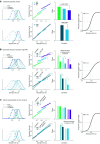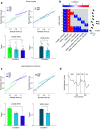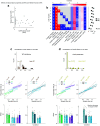Effects of Hallucination Proneness and Sensory Resolution on Prior Biases in Human Perceptual Inference of Time Intervals
- PMID: 37344236
- PMCID: PMC10359030
- DOI: 10.1523/JNEUROSCI.0692-22.2023
Effects of Hallucination Proneness and Sensory Resolution on Prior Biases in Human Perceptual Inference of Time Intervals
Abstract
Bayesian models of perception posit that percepts result from the optimal integration of new sensory information and prior expectations. In turn, prominent models of perceptual disturbances in psychosis frame hallucination-like phenomena as percepts excessively biased toward perceptual prior expectations. Despite mounting support for this notion, whether this hallucination-related prior bias results secondarily from imprecise sensory representations at early processing stages or directly from alterations in perceptual priors-both suggested candidates potentially consistent with Bayesian models-remains to be tested. Using modified interval timing paradigms designed to arbitrate between these alternative hypotheses, we show in human participants (16 females and 24 males) from a nonclinical population that hallucination proneness correlates with a circumscribed form of prior bias that reflects selective differences in weighting of contextual prior variance, a prior bias that is unrelated to the effect of sensory noise and to a separate index of sensory resolution. Our results thus suggest distinct mechanisms underlying prior biases in perceptual inference and favor the notion that hallucination proneness could reflect direct alterations in the representation or use of perceptual priors independent of sensory noise.SIGNIFICANCE STATEMENT Current theories of psychosis posit that hallucination proneness results from excessive influence of prior expectations on perception. It is not clear whether this prior bias represents a primary top-down process related to the representation or use of prior beliefs or instead a secondary bottom-up process stemming from imprecise sensory representations at early processing stages. To address this question, we examined interval timing behaviors captured by Bayesian perceptual-inference models. Our data support the notion that excessive influence of prior expectations associated with hallucination propensity is not directly secondary to sensory imprecision and is instead more consistent with a primary top-down process. These results help refine computational theories of psychosis and may contribute to the development of improved intervention targets.
Keywords: hallucinations; interval timing; perceptual inference; prior beliefs; psychosis; sensory resolution.
Copyright © 2023 Duhamel, Mihali et al.
Figures




Comment in
-
Evidence for a Primary Prior Deficit as a Mechanism of Auditory Hallucinations.J Neurosci. 2023 Dec 13;43(50):8579-8581. doi: 10.1523/JNEUROSCI.1601-23.2023. J Neurosci. 2023. PMID: 38092525 Free PMC article. No abstract available.
References
-
- Akaike H (1974) A new look at the statistical model identification. IEEE Trans Automat Contr 19:716–723. 10.1109/TAC.1974.1100705 - DOI
Publication types
MeSH terms
Grants and funding
LinkOut - more resources
Full Text Sources
Medical
